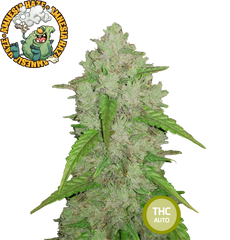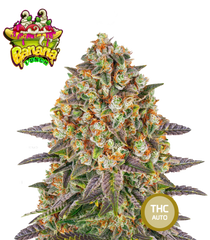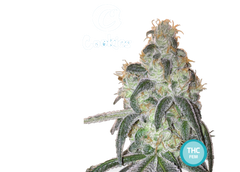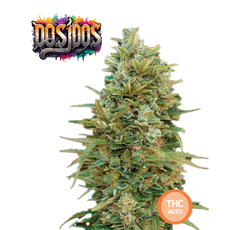Congratulations, you're interested in growing your own cannabis plants for the first time! But before you get that green thumb out of your way, you need to understand that growing marijuana indoors presents its own set of challenges for beginners, and the sheer amount of information available on the subject can be overwhelming. We've looked at the pros and cons of indoors vs. outdoors here , so check them out before you get started! ;)
Our guide to growing cannabis indoors will help simplify the process with clear, easy-to-digest sections designed to help the novice grower.
Step 1: Find a 'Room' or Grow Space for Your Cannabis
The first step to starting your own cannabis grow is to create a suitable space in which to do so. The space does not have to be a typical grow “room”; it could be a closet, a tent, a piece of furniture, a spare room, or the corner of an unfinished basement. Just keep in mind that you will need to choose your equipment (and plants) based on the space available.
Start Small…
When you tackle your first growing project, you need to start small for several reasons:
- The smaller the crop, the less expensive it will be to set up.
- It is much easier to keep a few plants under control than many.
- Your novice grower mistakes will be less damaging
Remember, most new cannabis growers will encounter setbacks along the way and lose plants to pests or disease. A failure to grow a couple of plants will cost you less than a failure to grow 15 plants.
…But Think Big
When designing your space, you need to consider not only how much space your plants will need, but also lights, air ducts, fans, and other equipment, as well as leaving yourself enough room to work. Cannabis plants can double or even triple in size at the start of flowering, so make sure you have enough room for height growth!
If your grow room is a cabinet, tent, or closet, you can simply open it up and remove your plants to work with; otherwise, you’ll want to make sure you leave yourself some wiggle room.
Cleanliness is Crucial
Make sure your space is easy to sanitize; cleanliness is important when growing indoors, so easy-to-clean surfaces are a must. Carpet, curtains, and raw wood are all difficult to clean, so avoid these materials if possible.
Make sure it is Lightproof
Another crucial criterion for a grow room is that it is light-proof. Light leaks during dark periods will confuse your plants and cause them to produce male flowers.
Other Variables
When deciding where to grow your cannabis, keep the following variables in mind:
- Convenience . You will need to monitor your plants carefully. Checking on them every day is important, and beginners will want to check multiple times a day until everything is set. If your room is difficult to access, this crucial step will be difficult.
- Temperature and Humidity Issues . If your grow space is already very hot or very humid, you will have trouble controlling the growing environment. It is recommended to choose a cool, dry area with easy access to fresh air from outside.
- Discretion . You’ll probably want to keep your grow safe from nosy neighbors and potential thieves, so be sure to pick a spot where noisy fans won’t attract any unwanted attention.
Step 2: Choose Your Cannabis Grow Lights
The quality of light in your grow room will be the deciding environmental factor in the quality and quantity of your cannabis harvests, so it’s a good idea to choose the best lighting setup you can afford. Here’s a quick rundown of the most popular types of cannabis grow lights used for indoor growing.
HID Grow Lights
HID (high intensity discharge) lights are the industry standard, widely used for their combination of output, efficiency, and value. They cost a little more than incandescent or fluorescent fixtures, but produce much more light per unit of electricity used. They are not as efficient as LEDs, however, but cost one-tenth as much per unit.
The two main types of HID lamps used for growing are:
- Metal halide (MH), which produce a bluish light and are generally used during plant growth
- High pressure sodium (HPS) lamps, which produce light more towards the red-orange part of the spectrum, and are used during the flowering stages.
Along with the bulbs, HID lighting systems also require a ballast and a reflector/hood for each light. Some ballasts are designed to work with either MH or HPD bulbs, while some newer ones will work with both.
If you can't afford both MH and HPS bulbs, start with HPS, as they provide more light per watt. Magnetic ballasts are cheaper than digital, but they run hotter, are less efficient, and are harder on the bulbs. Digital ballasts are generally a better option, but are more expensive. Be careful with cheap digital ballasts, as they are often poorly shielded and can create electromagnetic interference that will affect radio and WiFi signals.
Unless you are growing in a large, open space with plenty of ventilation, you will need reflective hoods to cool the air under which you mount your lights, as HID bulbs produce a lot of heat. This requires ducting for air exchange, which will increase your initial cost but will make controlling the temperature in your grow room much easier.
Fluorescent Grow Lights
Fluorescent lighting systems, especially those that use high-output (HO) lighting, are quite popular among small-scale growers for the following reasons:
- They tend to be less expensive to install, because the reflector, ballast and bulbs are included in one package.
- They do not require a cooling system because they do not generate the amount of heat as HIDs
The main downside is that fluorescent lights are less efficient, generating about 20-30% less power per watt of electricity used. And space is another issue, because to get the output of a single 600-watt HPS bulb, you would need about four 12-inch T5 HO bulbs.
LED Grow Lights
LED (light emitting diode) technology has been around for a while, but has only recently been adapted to create super efficient indoor grow light systems. The main downside with LED grow lights is their cost: well-made systems can cost up to 10 times more than HID ones. The benefits are that LEDs last much longer, use much less electricity, create less heat, and the best ones produce a fuller spectrum of light, which can lead to larger yields and better quality.
Unfortunately, there are a lot of inferior LED lights being made and sold to growers, so do some research and read product reviews before giving away your hard earned money.
Induction Grow Lights
Induction lamps, also known as electrodeless fluorescent lamps, are another older technology that has recently been adapted to meet the needs of indoor growers. Invented by Nikola Tesla in the late 1800s, the induction lamp is essentially a more efficient and long-lasting version of the fluorescent light bulb. The main disadvantages with these systems are their price and availability.
Step 3: Give Your Cannabis Plants Air

Plants need fresh air to thrive, and carbon dioxide (CO2) is essential in the process of photosynthesis. This means you will need a constant flow of air through your grow room, which can be easily achieved with an exhaust fan near the ceiling of the room to remove the warmest air, and a filtered air intake on the opposite side, near the floor.
You will want to make sure that the temperature stays in a comfortable range for your plants, between 20 and 30°C when the lights are on, and between 15 and 20°C when they are off. Some cannabis strains (usually sativa strains) prefer the lower end of the range, while others tolerate higher temperatures better.
The size of your exhaust fan will depend on the size of your grow space and the amount of heat your lighting system generates. HID systems produce a lot of heat, especially if they don’t have air-cooling hoods. People who live in warmer regions often leave their lights on at night to try to keep their grow temperatures down.
It is a good idea to set up your lights, let them run for a while, and then determine how much airflow you need to maintain a comfortable temperature for your plants. This will allow you to choose an exhaust fan that will work for you. If the smell of flowering cannabis plants is a problem for you, consider adding a carbon filter to your exhaust fan.
Alternatively, you can create a sealed artificial environment using an air conditioner, dehumidifier and supplemental CO2 system, but this is quite expensive and not recommended for the novice grower.
Finally, it’s a good idea to have a constant gentle breeze in your grow room, as this strengthens the stems of your plants and creates a less hospitable environment for mold and flying pests. A well-mounted circulating fan works well for this purpose – just don’t point it directly at your plants, as it can cause wind damage.
Step 4: Choose Your Controls and How to Monitor
Once you have selected your lights and climate control equipment, you will want to automate their functions. While there are sophisticated (and expensive) units available to control lights, temperature, humidity, and CO2 levels, the beginner will generally need a simple 24-hour timer for the lights, and an adjustable thermostat switch for the exhaust fan.
Timing your light/dark cycle is very important when growing cannabis; in general, you will want to keep your lights on for 16-20 hours a day while your plants are in vegetative growth, and then switch to 12 hours of light a day when you want them to flower. You need your lights to turn on and off at the same time every day, or you risk stressing your plants, so a timer is essential. You can also use a timer for your exhaust fan, but spending a few extra bucks on a thermostat is a much better option.
With the most basic models, you simply set the thermostat to the maximum temperature you want for your space and plug in the exhaust fan. Once the temperature reaches the level you set, it will turn on the fan until the temperature drops a few degrees below the set threshold. This will save energy and maintain a stable temperature.
Since you probably won’t be spending much of your time in your grow space, a hygrometer/thermostat combo with a high/low memory option can be very useful for keeping an eye on the conditions in your room. These small, inexpensive devices not only show you the current temperature and humidity, but also the highest and lowest readings for the period of time since you last checked.
Another good idea is to keep a pH meter or test kit on hand so you can check the pH level of your water, nutrient solution, or soil. Cannabis prefers a pH between 6 and 7 in soil, and 5.5 to 6.5 in hydroponic media. Letting the pH go out of this range can lead to “nutrient lockout,” meaning your plants won’t be able to absorb the nutrients they need, so make sure you check your water and soil regularly, and that the nutrient mix you’re feeding your plants is within the desired range.
Step 5: Decide on a Medium for Growing Cannabis
Growing indoors means you have a variety of methods to choose from, and whether it’s pots filled with soil the old fashioned way, or a slab of rockwool in a hydroponic cart, each medium has its benefits and drawbacks. Here we’ll look at the two most popular methods and the medium they use.
Earth
Soil is the most traditional medium for growing cannabis indoors, as well as the most forgiving, making it a good choice for novice growers. Any high-quality soil will do, as long as it doesn’t contain a time-released artificial fertilizer, which is not suitable for growing good cannabis.
A very good choice for beginners is pre-fertilized organic soil (often called super soil), which can grow cannabis plants from start to finish without adding nutrients, if used correctly. You can make it yourself by combining worm castings, bat guano, and other components with a good soil, then letting it sit for a few weeks, or you can buy it already made in many stores.
As with all organic growing, this method relies on a healthy population of mycorrhizae and soil bacteria to help convert organic matter into nutrients that can be used by the plant. Alternatively, you can use a regular potting mix and then give your plants liquid nutrients when the soil runs out.
Without Soil (aka Hydroponics)
Indoor growers are turning to the soilless, hydroponic medium of growing cannabis plants. This method requires feeding plants through concentrated solutions of mineral salts, which are absorbed directly by the roots through osmosis. This technique allows plants to be fed faster, which leads to greater growth and yield, but it also requires more precision, as plants react more quickly to being over- or under-fed, and are more susceptible to nutrient burn or lockout.
Different materials used include rockwool, vermiculite, clay pebbles, perlite, and coco coir, to name a few. Commercial soilless mixes are widely available, and combine two or three of these media to create an optimal growing mix. Soilless media can be used in automated hydroponic setups or in individual containers that are watered by hand.
Step 6: Determine What to Grow Your Cannabis In

The type of container you use will depend on your medium, system, and the size of your plants. A water-and-drain cart style system might need small net pots with clay pebbles, or just a slab of rockwool to grow lots of seedlings, while a “super-soil” grow might need 40L plastic pots to grow a few large plants.
Inexpensive options include disposable perforated plastic bags or fabric bags, while others choose to spend more on “smart pots,” containers designed to improve airflow in the root zone of the plant. Many people grow their first cannabis plants in 5 gallon buckets. Drainage is the most important thing though, as cannabis plants are very sensitive to waterlogged conditions, so if you want to reuse other containers, make sure to poke holes in the bottom and place them on trays.
Step 7: Give Your Cannabis Plants Nutrients
Growing high-quality cannabis flowers requires more fertilizer, or nutrients, than most regular grows. Your plant needs the following primary nutrients (collectively known as macronutrients, which we’ve put together a guide for here ):
- Nitrogen (N)
- Phosphorus (P)
- Potassium (K)
These micronutrients are also needed, but in much smaller quantities:
- Soccer
- Magnesium
- Iron
- Copper
If you are not using a pre-fertilized organic soil mix, you will need to feed your plants at least once a week, using an appropriate nutrient solution. These nutrients are sold as either concentrated liquids or powders that are mixed with water, and are generally formulated for either vegetative growth or flowering. This is because Cannabis requires different nutrients throughout its life cycle: it needs more nitrogen during vegetative growth, and more phosphorus and potassium during bud production.
Most macronutrients are sold in a two-part liquid form, to prevent some elements from precipitating (combining into an inert solid that is unusable for the plant), which means you will need to buy two bottles (part A and part B) for the veg phase, and two bottles for the grow, along with a bottle of micronutrients. Aside from these basics, the only other product you may need to buy is a Cal/Mag supplement, as some strains require more calcium and magnesium than others.
Once you have purchased all the necessary nutrient products, simply mix them with water as directed on the label and water your plants with this solution. You should always start with half the recommended amount, as cannabis plants burn easily. It is almost always worse to give your plants too much nutrients than too little, and over time you will learn to “read” your plants, looking for signs of deficiencies or excesses.
Step 8: Water Your Cannabis Plants
Most people don’t think twice about the water they use to water their plants; if you can drink it, it’s probably fine, right? Well, that may not always be a problem, depending on where you are, but some waters contain a high concentration of dissolved minerals that can build up in the root zone and affect nutrient uptake, or they may contain fungi or other pathogens that aren’t harmful to people, but can lead to root disease.
Additionally, some places may have high levels of chlorine in their water supplies, which can be detrimental to some beneficial soil microbes. For these reasons, many people choose to filter the water they use in their garden.
The most important thing to remember at this stage is not to overwater. Cannabis plants are very susceptible to fungal root diseases when they are too wet, and overwatering is one of the most common mistakes made by novice growers. How often to water your plants will depend on the medium you use, the size of the plants, and the ambient temperature. Some people wait until the lower leaves of the plant begin to curl slightly before watering.
As you gain experience and knowledge, you will modify your grow room and equipment to better suit your particular environment, the growing techniques you use, and the specific strains you choose, but hopefully this article will give you a solid foundation of knowledge to get you started on the right foot. And remember, growing Marijuana is a labor of love, so spend lots of time with your plants and have fun!









